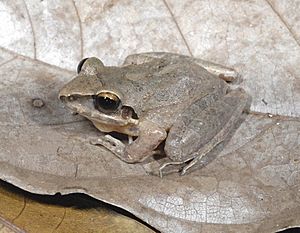Lyman's robber frog facts for kids
Quick facts for kids Lyman's robber frog |
|
|---|---|
 |
|
| Conservation status | |
| Scientific classification | |
| Synonyms | |
|
Pristimantis lymani, also known as Lyman's robber frog, is a type of frog. It belongs to a large family of frogs called Strabomantidae. This small frog lives in the wild mountains of southern Ecuador and northern Peru.
Lyman's robber frog makes its home in cool, misty montane forests. It also lives in areas called sub-páramo and páramo. These are high-altitude grasslands with shrubs, often found above the tree line. You might find these frogs hiding under stones near streams. They also live inside large bromeliad plants that grow on rocky slopes and cliffs. Even though these frogs are common, their homes are slowly disappearing. This is called habitat loss.
Contents
About Lyman's Robber Frog
Lyman's robber frog was first described in 1920. Scientists Thomas Barbour and Gladwyn Kingsley Noble gave it its scientific name. Like many frogs, it plays an important role in its ecosystem. Frogs help control insect populations. They also serve as food for other animals.
Where Do They Live?
These special frogs live in the Andes Mountains. Their home stretches across parts of Ecuador and Peru. They prefer cool, wet places high up in the mountains. This includes cloud forests and open grasslands. The climate in these areas is often damp and misty. This makes it perfect for frogs.
What Do They Look Like?
Lyman's robber frogs are usually small. Their skin color helps them blend in with their surroundings. This can be shades of brown, green, or gray. This camouflage helps them hide from predators. Like other frogs, they have moist skin. This skin helps them breathe and absorb water.
Life in the Wild
These frogs are often active at night. They hunt for small insects and other invertebrates. They use their long, sticky tongues to catch their prey. During the day, they might hide to stay safe. They find shelter under rocks or inside plants. This helps them avoid predators and stay cool.
Reproduction and Life Cycle
Unlike many frogs, Pristimantis frogs do not lay their eggs in water. Instead, they lay their eggs on land. The eggs hatch directly into tiny froglets. There is no tadpole stage. This unique way of reproducing helps them live in drier mountain areas. It also means they do not need ponds or streams for their young.
Protecting These Frogs
Lyman's robber frog is currently listed as "Least Concern." This means it is not in immediate danger. However, its population is stable but faces threats. The biggest threat is habitat loss. Forests are being cut down for farming and other human activities. This takes away the frogs' homes. Protecting these mountain habitats is important. It helps ensure these unique frogs can continue to thrive.
See also
In Spanish: Pristimantis lymani para niños


